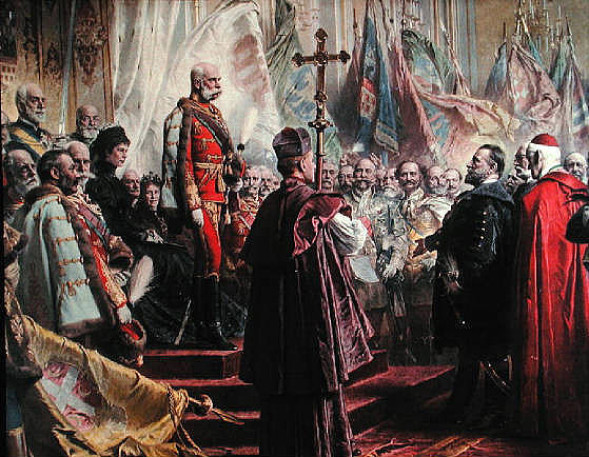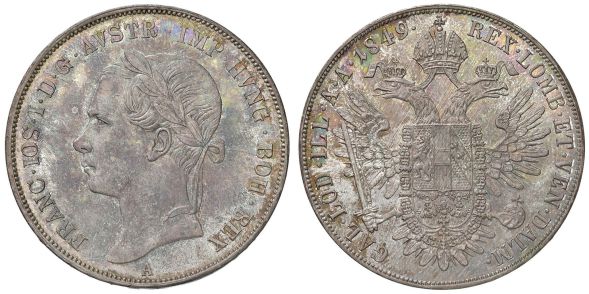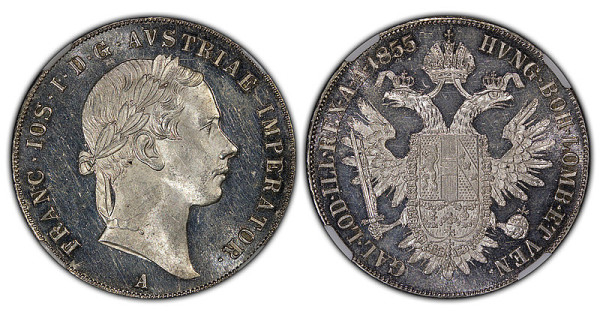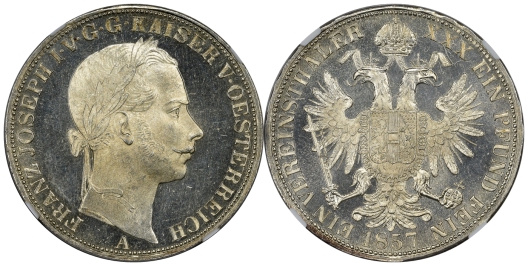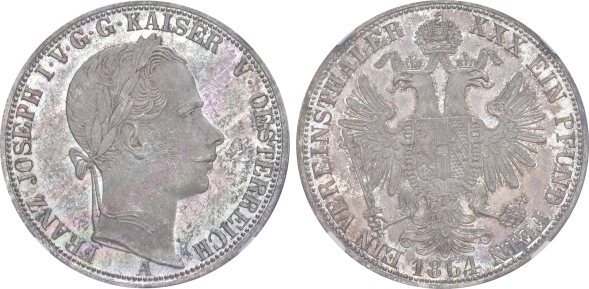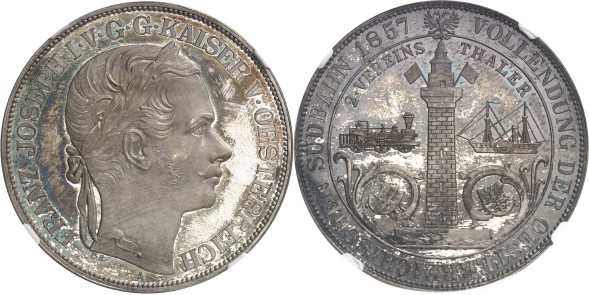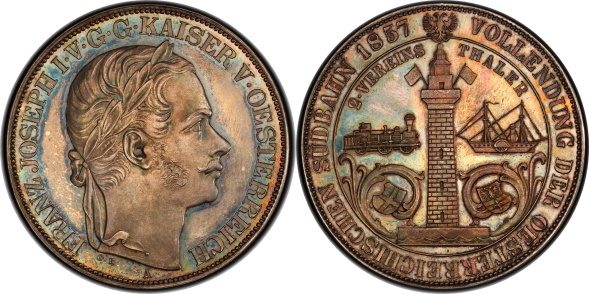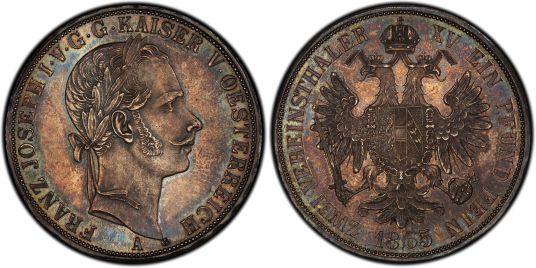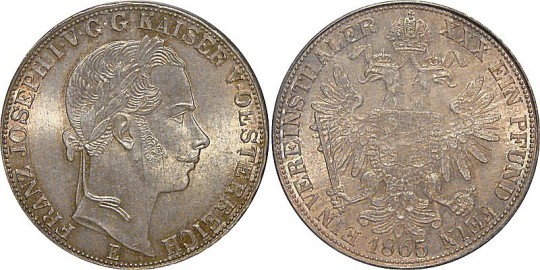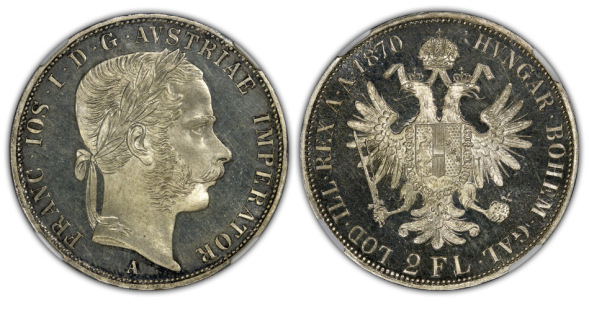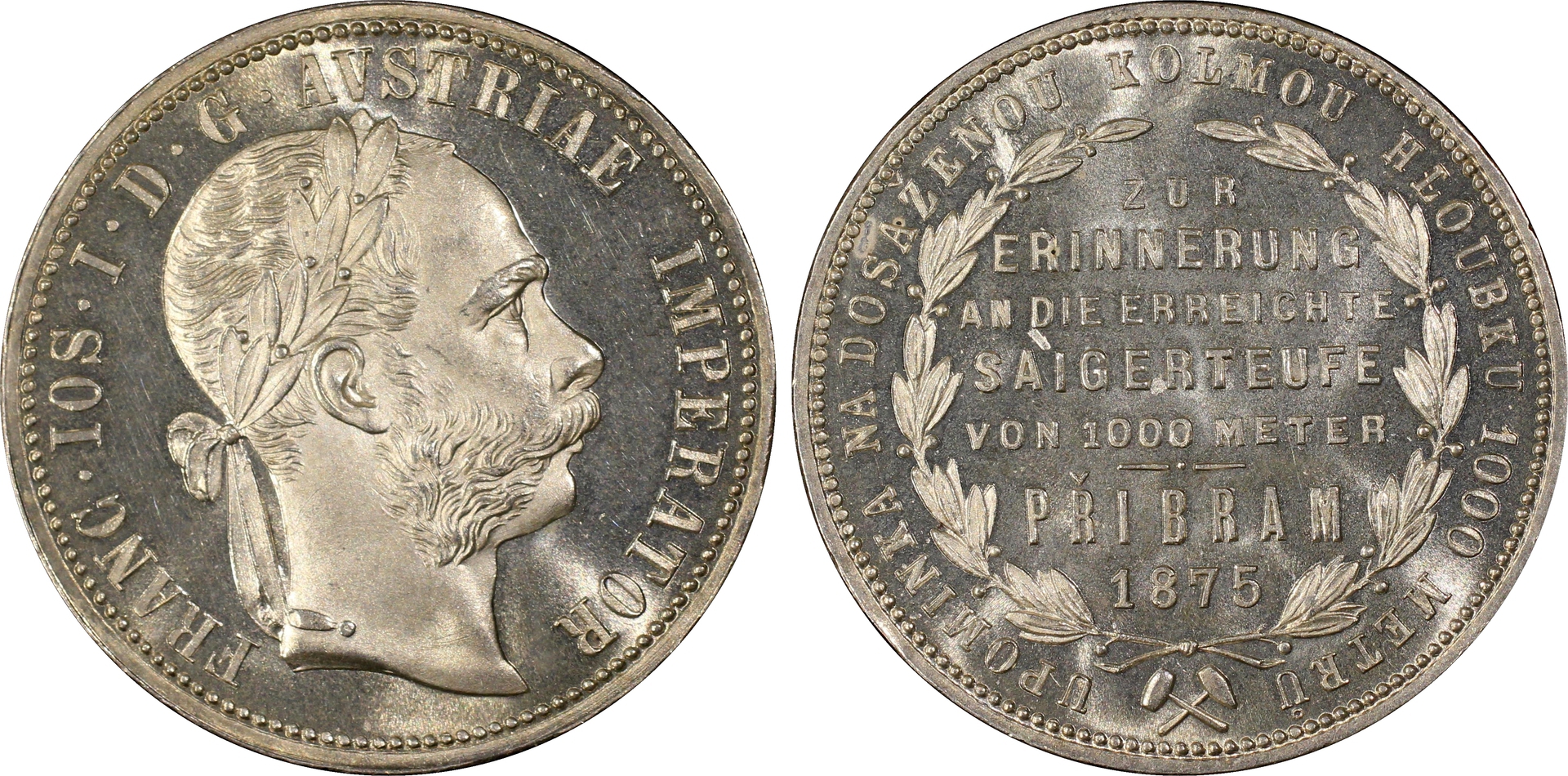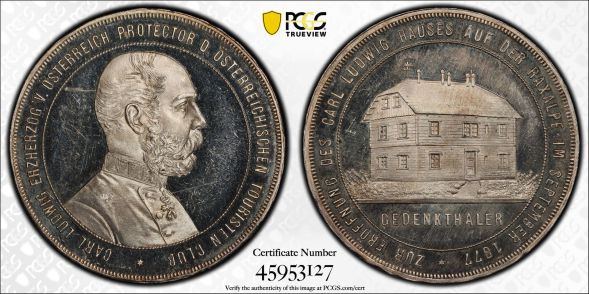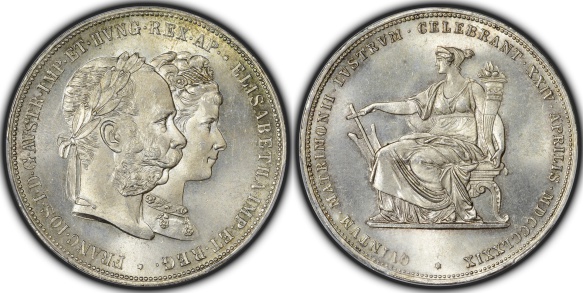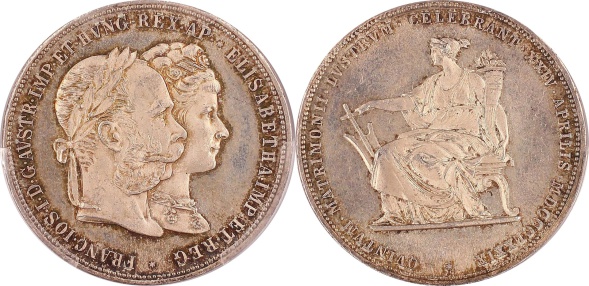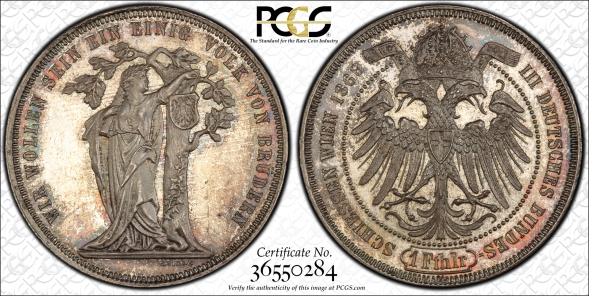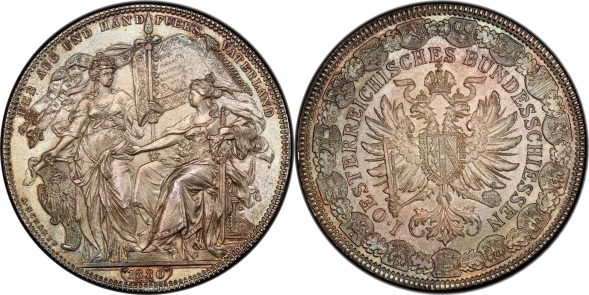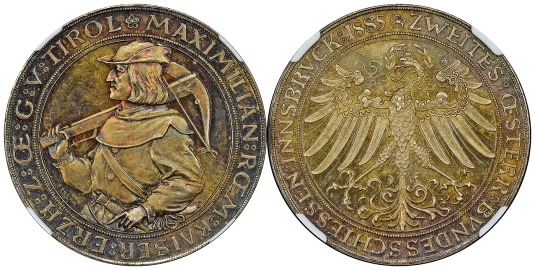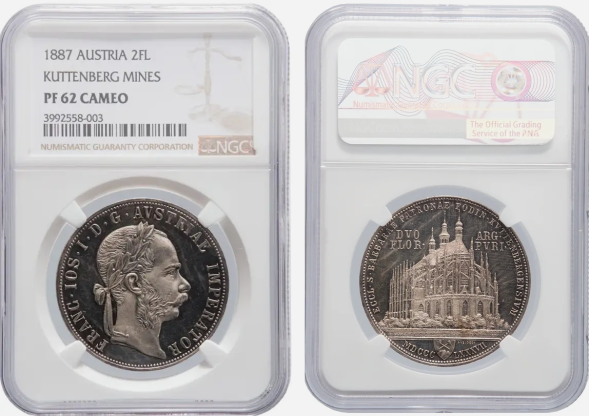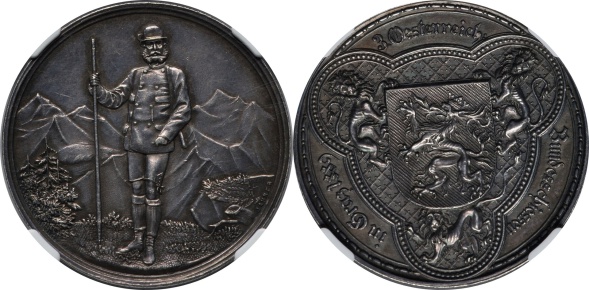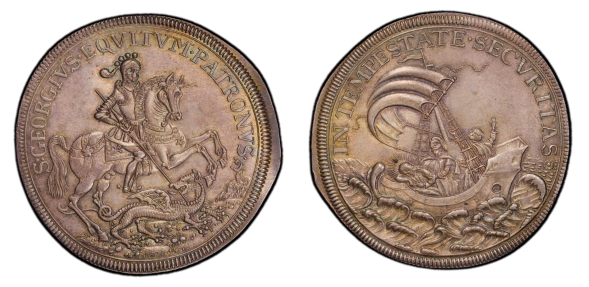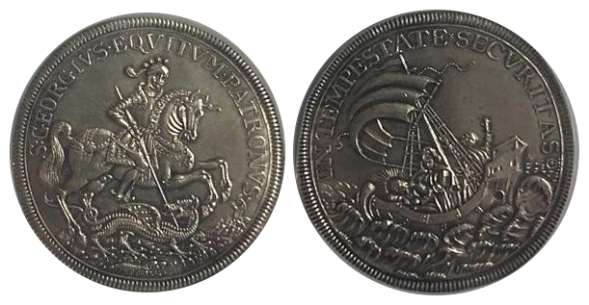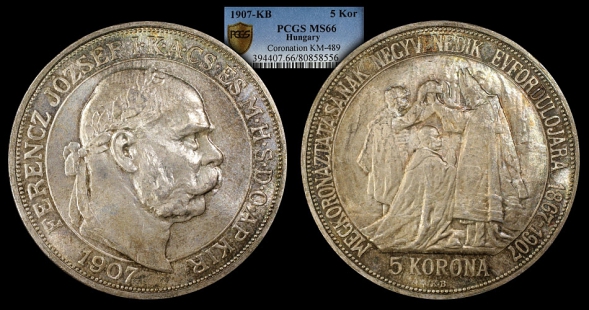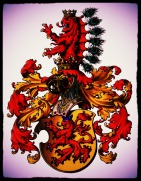Francis Joseph I (1848–1916)
1849-A. Emperor of Austria Franz Joseph (1848-1916) Thaler. Lower Austria, Vienna Mint. DAV-15. Frühwald 1345. Spectacular rare coin with satiny surfaces. The only one in GEM condition. NGC MS-65.
All dates of these coins were minted in 1852 based on the draft of the main mintmaster Johann Ritter von Hassenbauer to commemorate the first dates of ruling of Franz Joseph. Originally, only 12 pieces of every date and nominal were minted, two months later were minted another 10 pieces of every date and nominal (see Cubasch p. 21). One month later, there was another demand for the delivery of an unspecified number of coins for public and church collections, the fulfillment of which was not confirmed.
These coins were not intended for circulation but for representative purposes, and were distributed to senior state officials, devoted to state, church and several private collections. One piece of each date was given to emperor’s hands. Interesting is the thaler of 1852 from the Vienna mint (this sheet), which was minted on April 14th 1852 as a pattern strike, in number of only 10 pieces. The title of dalmatian king was omitted in the inscription. Based on the instructions of the emperor, the title was added in the next dates (1848 – 1851). The Emperor however was not satisfied with the portrait to the left, so he was portrayed from the right at all later thalers.
1857. Austria, Empire. Franz Joseph I. Emperor, 1848-1916. 1857 Southern Railway 2 Thaler. Mint Place: Vienna (A). Engraver: Carl Radnitzky. Silver. 41mm. DAV-20. Herinek: 821. KM-2246.1. Variety. Mintage: 1,644. On 27 July 1857, the Austrian railway company k.k. Südliche Staatsbahn (SStB) completed the construction of Trieste's first railway facilities. On the same day, in the presence of the Austrian Emperor Franz Joseph I, the new terminal station at Trieste, including its relatively modest original passenger building designed by the engineer Carl Ritter von Ghega was officially opened. The inclusion of Trieste in the main axis of the Austrian Südbahn generated an economic upswing in the largest and most important port city ruled by the Austrian monarchy, and strengthened its position in the Habsburg Empire. The present day rail network of the city of Trieste is based, for the most part, upon railway lines constructed by the former Austrian Empire.
Lustrous, iridescent piece with outstanding eye appeal. Untouched with cabinet patina. NGC PF-65+.
1857. Austria, Empire. Franz Joseph I. Emperor, 1848-1916. 1857 Southern Railway 2 Thaler. Mint Place: Vienna (A). Engraver: Carl Radnitzky. Silver. 41mm. DAV-20. Herinek: 821. KM-2246.2. Variety. Mintage: 1,644. Scarce type with a very low total mintage of which a few have survived in this select premium quality. Iridescent piece with outstanding eye appeal and undergraded. NGC PR-63.
1865-A. Austria. Emperor of Austria Franz Joseph (1848-1916) 2 Thaler. Vienna mint. DAV-23. KM-2249. Mintage: 7,425. Obv: Laureate head right. Rev: Crowned imperial double eagle. With definite eye appeal, this immense multiple Taler features the laureate head of Franz Joseph and the representative crowned, double-headed eagle upon the reverse. The surfaces are beautifully styled, with bold central detail heightened by the collection of charcoal color at the edges, and only mild handling observed throughout the fields. Rarely offered at the Mint State level, and an exciting opportunity as such. PCGS MS-62.
1875. AUSTRIA. Franz Joseph (1848-1916) Pribram Gulden (Florin). 29mm, 12.31gr. J. 365; Müseler 6/44. Y-17. KMX-M2. Rare commemorative marking the exploration of the Adalbert mine in Přibram reaching 1000 meters depth. Mintage of 8,000. Obv: Laureate head right. Rev: Slovak commemorative legend surrounds wreath UPOMINKA NA DOSAZENOU KOLMOU HLOUBKU 1000 METRU, with same in German equivalent in wreath. Edge shows the standard coinage motto, incuse VIRIBVS VNITIS - By United Strengths. Magnificent luster for this key coin of the entire Austrian commemorative series. PCGS MS-66+, likely the finest known.
1877. Austria. Vienna Mint. Franz Joseph I (1848-1916) Specimen "Carl-Ludwig House" Taler. DAV-30, J-371, Thun-462. Struck for the opening of the Carl-Ludwig House in the Rax (Alpine mountain range). This type was created in an extremely limited mintage of only 100 examples, guaranteeing its unavailability to all but a few collectors. PCGS SP-64 DCAM
The rapid development of towns and town society in the second half of 19th century brought upon a rich social life. Its essential part were various fellowships and associations. Shooting associations count to the most prestigious ones and used to group together people interested in sport shooting. The shooting associations were organized in country shooting unions. An essential social event in 1879 was the foundation of Austrian state shooting club in Vienna. The prestige of annual union gatherings, so-called shootings, was directly derived from the social status of attendees and the shooters' reputation. Valuable rewards were prepared for the attendees, just as high financial rewards for winners in shooting disciplines. Besides tea and coffee sets and golden wrist watches, medals in various sizes and from various metals were also popular commemoration objects. The choice of size and material was to indicate the social prestige and various sport achievements of the attendees. The number of minted medals usually corresponded with the number of awarded persons, the rest of medals was used as giveaways to important persons and institutions. For instance, the last three large silver medals from Olomouc shooting of 1884 the union's board gave off to the union treasury chamber, the historical museum in Olomouc and the emperor. Shooting medals immediately became popular collectional objects for their rarity and have stayed until the present time.
1868. Austria, Franz Joseph I. 3rd German Federal Shooting Festival in Vienna. Shooting Thaler (1 Feinthaler). Designer: Seidan. DAV-28, KM-XM8; Thun-46. Vienna Mint. Obv: Wreathed and togate female allegorical figure, shouldering fasces and hanging a shield with a double-headed imperial eagle on an oak-tree. Designer´s signature (SEIDAN) below ground. Legend: WIR WOLLEN SEIN EIN EINIG VOLK VON BRÜDERN ("We (the German nations of the Empire) want to be united people of brothers!"). Rev: Imperial crown above nimbate double-headed eagle with shield of Vienna at chest. Legend: III DEUTSCHES BUNDES (1 Fthlr) SCHIESSEN WIEN 1868 ("3rd German Federal (1 Fine Thaler) Shooting Vienna 1868"). PCGS MS-65.
1880. Austria. Emperor Franz Joseph I (1848 – 1916) 2 Florin. Vienna Mint. 36mm. Engraver Anton Scharff. DAV-32. KM-XM6. Peltzer, 1932; Hauser 5101; Thun 465. Frühwald 1911. Steulm. P.125, 1; ANK 55; 1911.Struck to commemorate the First Federal Shooting Festival On the occasion of the Austrian Confederation in Vienna, 1880. Obv: Crowned Double Eagle in Coat of Arms. Rev. Standing city goddess, Vindobona, with flag and coat of arms next to the sitting Austria. Lightly-patinated surfaces accented by iridescent hues of turquoise and amber residing within the reverse motifs. Intricately-designed and with undeniable eye-appeal, endlessly collectible at this Gem level of preservation. PCGS MS-65.
1885. Emperor Franz Joseph I (1848-1916) 2 Gulden. 36mm. 22.28g. Commemorative issue for the 2nd Austrian Federal Marksmanship Shooting Festival at Innsbruck. Vienna Mint. Horsky-6309. Peltzer-1879. Design: A. Scharff and A. Busson. Obv: Emperor Maximilian I crowned as the winner in Tyrolean hunting dress, crossbow on the right shoulder. Rev: Coat of arms, double eagle. Superb iridescent toning with lots of underlying luster. NGC MS-66.
1887 Austria. Emperor Franz Joseph I (1848-1916) 2 Gulden. Vienna Mint. Reopening of the Kuttenberg silver mines. DAV-33. KM-XM7, Thun-467. Frühwald 1904a, Davenport 33, Moravec 69a, Novotný 155 (AR), Herinek 1136. Struck to commemorate the reopening of the Kuttenberg mines, which traces its roots back to the medieval period as a powerful commercial and political center of Bohemia, second only to Prague until the modern era. An exceedingly scarce issue with a total mintage of 400, with only a fraction being original Proofs. Covetable in any grade, let alone near-choice, and boasting a metallic backdrop that supports the heavily frosted and meticulously engraved raised features, decorated with scattered wisps that define the grade but do little to hinder the overall aesthetic appeal of this fleeting and highly collectible commemorative issue. NGC PF-62 Cameo.
Commemorative medals became in 18th century already a tool of state propagation and were issued not only at coronations, but also at important political and national economic events. The economic and
political blossom of the monarchy at the reign of Kaiser Franz Joseph I. brought upon a series of events, the meaning of which had to be emphasized by publishing some very popular commemoration
medals. Awarding medals to important personalities belonged to essential rituals of contemporary social and political life. Most notable contemporary medal designers and engravers were appointed to
artistically design the medals. Names as Marschall, Neuberger, Neudeck, Radnitzky, Seidan, Scharff, Tautenhayn were a guarantee for the highest artistic quality. The long reign of Franz Joseph I.
initiated the creation of a unique collection of portrait medals, that literally constitute an artistic gallery of the second half of 19th and the beginning of 20th century. The changing Kaiser
portrait design reflects not only his age from 18-year-old young man to a dignified old man, but also certain changes of artistic style according to the contemporary fashion. While the Emperor is
getting older on the portraits with age, the used artistic style is getting younger. The artistic medal design from the last periods of reign clearly anticipates the coming wave of modernism. Because
of the outstanding artistic qualities, the most notable contemporary collectors added governmental medals into their collections. They became jewels in collections of Kilián, Donnebauer,
Windischgrätz, Berger, Horsky, Lanna, Hollschek and Chaura and have stayed until today. Hardly any larger collection of Franz Joseph I. coins can be imagined without at least some medals with the
portrait of the long-lived emperor. To create a specialized collection, a large portion of collector's ascetism and patience is needed because of the rarity of some pieces.
In 1896, the Hungarians commemorated the thousandth anniversary of the arrival of hungarian tribes to the Carpathian (Pannonian) basin. To this millenium belongs (besides monumental celebrations of the Hungarian nation) a group of some exceptional and very heterogeneous commemoration medals. These strikes immitate some notable historical strikes (e.g. Denar of St. Stephen, Andrew II., Groschen or Goldgulden of Charles Robert or Thaler of St. George or Ferdinand I., occurring as a golden 9 Ducat struck as well).
HUNGARY. 1896-KB Taler. X-13; Herinek-1106. Fruhwald 2205. Adamo KE11.1, Moravec 214. Resembling the Emperor Ferdinand I (1526-1564) design. Millenium coinage for the celebration of the 1000 years for the conquest of Hungary. Obv: Half-length bust right holding orb and sceptre. Rev: Madonna and child above shield. Original strike. 100 pieces minted. Superbly toned matte gem, an extremely rare type and one of the finest surviving examples. NGC MS-65.
1896. Hungary. Franz Joseph I. (1848-1916) Millennium George's Thaler. Kremnitz Mint. 45 mm . 26.78 g. Frühwald: 2206, Herinek 1107. Adamo KE11, Moravec 215. Mz .: 348, Gohl: N.K.1904.S.65, Tower: 897, Millenium coinage for the millennium celebration of the conquest of Hungary, applying Christian Hermann Roth designs depicting St. George slaying the dragon. Obv: Av: S: GEORGIVS • EQVITVM • PATRONVS • dragonfighting St. George's horse right, bottom of the year 1896. Rev: Rv: IN TEMPESTATE • SECVRITAS * in a sailboat storm, sleeping Jesus and the twelve apostles. Scarce with mintage of 100 pieces. PCGS MS-63.
1896. Hungary. Franz Joseph I. (1848-1916) Millennium George's Thaler. Kremnitz Mint. 45 mm . 26.78 g. Frühwald: 2206, Herinek 1107. Adamo KE11, Moravec 215. Mz .: 348, Gohl: N.K.1904.S.65, Tower: 897, Millenium coinage for the millennium celebration of the conquest of Hungary, applying Christian Hermann Roth designs depicting St. George slaying the dragon. Obv: Av: S: GEORGIVS • EQVITVM • PATRONVS • dragonfighting St. George's horse right, bottom of the year 1896. Rev: Rv: IN TEMPESTATE • SECVRITAS * in a sailboat storm, sleeping Jesus and the twelve apostles. Scarce with mintage of 100 pieces. NGC MS-63.
1907-KB. Hungary. Kremnitz mint. Emperor Franz Joseph I (1848-1916) 5 Korona. 36.1mm, 23.94gr. DAV-124. Huszar: 2214: Her 779. Jaeger: 416. KM-489. Mintage: 300,000. Commemorative issue for the 40th anniversary of coronation. Obv: Laureate bust of Franz Joseph I right. Rev: Coronation scene at Buda, showing kneeled Emperor, being coronated by an Archbishop inside church. Attractive, deep envelope toning. This is an original striking. PCGS MS-66.

